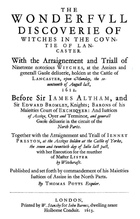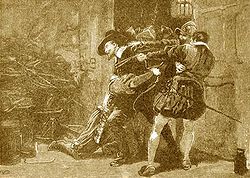
The Wonderfull Discoverie of Witches in the Countie of Lancaster
Encyclopedia

York
York is a walled city, situated at the confluence of the Rivers Ouse and Foss in North Yorkshire, England. The city has a rich heritage and has provided the backdrop to major political events throughout much of its two millennia of existence...
they took place at Lancaster
Lancaster, Lancashire
Lancaster is the county town of Lancashire, England. It is situated on the River Lune and has a population of 45,952. Lancaster is a constituent settlement of the wider City of Lancaster, local government district which has a population of 133,914 and encompasses several outlying towns, including...
Assizes. Of the twenty men and women accused – amongst them the Pendle witches
Pendle witch trials
The trials of the Pendle witches in 1612 are among the most famous witch trials in English history, and some of the best recorded of the 17th century. The twelve accused lived in the area around Pendle Hill in Lancashire, and were charged with the murders of ten people by the use of witchcraft...
and the Samlesbury witches
Samlesbury witches
The Samlesbury witches were three women from the Lancashire village of Samlesbury Jane Southworth, Jennet Bierley, and Ellen Bierley accused by a 14-year-old girl, Grace Sowerbutts, of practising witchcraft. Their trial at Lancaster Assizes in England on 19 August 1612 was one in a series of...
– eleven were found guilty and subsequently hanged; one was sentenced to stand in the pillory
Pillory
The pillory was a device made of a wooden or metal framework erected on a post, with holes for securing the head and hands, formerly used for punishment by public humiliation and often further physical abuse, sometimes lethal...
, and the rest were acquitted.
Thomas Potts, the clerk to the Lancaster Assizes, was ordered by the trial judges, Sir James Altham and Sir Edward Bromley, to write an account of the proceedings, making them some of the most famous and best recorded witch trials of the 17th century. Potts completed the work on 16 November 1612, and submitted it to the judges for review. Bromley revised and corrected the manuscript before its publication in 1613, declaring it to be "truly reported" and "fit and worthie to be published".
Historian Stephen Pumfrey has suggested that Bromley and Altham worked closely with Potts in the writing of The Wonderfull Discoverie "to manipulate the extraordinary records into an account that would protect and advance their careers". Potts' book has been called the "clearest example of an account [of a witch trial] obviously published to display the shining efficiency and justice of the legal system". Although written as an apparently verbatim account, Potts was not reporting what had actually been said during the trials; he was reflecting what had happened.
Thomas Potts
The author of The Wonderfull Discoverie, Thomas Potts, was brought up in the home of Thomas KnyvetThomas Knyvet, 1st Baron Knyvet
Thomas James Knyvet, 1st Baron Knyvet was the second son of Sir Henry Knyvet of Charlton, Wiltshire and Anne Pickering, daughter of Sir Christopher Pickering of Killington, Westmoreland. His half-sister Catherine Knyvet was married to Thomas Howard, 1st Earl of Suffolk...
, the man who in 1605 was credited with apprehending Guy Fawkes
Guy Fawkes
Guy Fawkes , also known as Guido Fawkes, the name he adopted while fighting for the Spanish in the Low Countries, belonged to a group of provincial English Catholics who planned the failed Gunpowder Plot of 1605.Fawkes was born and educated in York...
in his attempt to blow up the Houses of Parliament and thus saving the life of King James I
James I of England
James VI and I was King of Scots as James VI from 24 July 1567 and King of England and Ireland as James I from the union of the English and Scottish crowns on 24 March 1603...
. At the time of writing his book, Potts was lodging in Chancery Lane
Chancery Lane
Chancery Lane is the street which has been the western boundary of the City of London since 1994 having previously been divided between Westminster and Camden...
, in London.
Potts was employed as a clerk of the peace
Clerk of the Peace
A clerk of the peace held an office in England and Wales whose responsibility was the records of the Quarter Sessions and the framing of presentments and indictments. They had legal training, so that they could advise justices of the peace.-England and Wales:...
for the East Riding of Yorkshire
East Riding of Yorkshire
The East Riding of Yorkshire, or simply East Yorkshire, is a local government district with unitary authority status, and a ceremonial county of England. For ceremonial purposes the county also includes the city of Kingston upon Hull, which is a separate unitary authority...
in about 1610–11, and was an associate clerk on the northern assize
Assizes (England and Wales)
The Courts of Assize, or Assizes, were periodic criminal courts held around England and Wales until 1972, when together with the Quarter Sessions they were abolished by the Courts Act 1971 and replaced by a single permanent Crown Court...
circuit in the summer of 1612, when the Lancashire witch trials took place. Although he had sufficient legal training to be able to advise Justices of the Peace
Justice of the Peace
A justice of the peace is a puisne judicial officer elected or appointed by means of a commission to keep the peace. Depending on the jurisdiction, they might dispense summary justice or merely deal with local administrative applications in common law jurisdictions...
, he had not received a university education. The normal career progression for a man in his position would have been a slow promotion to Clerk of the Assize, but only a few years after the publication of his book Potts began to receive "considerable royal favour", suggesting that his account of the trials met with the King's approval. King James was keenly interested in the breeding of hounds, and in 1615 Potts was rewarded with "the keepership of Skalme Park ... for the breeding and training of hounds". Three years later he was granted "the office of collecting the forfeitures on the laws concerning sewers, for twenty-one years", a position that gave him the authority to appoint deputies.
17th-century jurisprudence
Potts has been described as an "active and selective reporter"; he omits significant details of court procedure in the early 17th-century English legal process, such as that all indictments were initially submitted to a grand juryGrand jury
A grand jury is a type of jury that determines whether a criminal indictment will issue. Currently, only the United States retains grand juries, although some other common law jurisdictions formerly employed them, and most other jurisdictions employ some other type of preliminary hearing...
, whose task was to decide whether there was a prima facie case against the accused before the prisoners were taken into the courtroom to be tried by the petty jury, the forerunner of the modern jury. The accused witches would not have been tried separately as Potts' account suggests, but in groups. Potts also represents written depositions as if they had been spoken in court, and he almost certainly "improved" Bromley's speeches.
Researcher Marion Gibson has suggested that "Potts and other pamphleteers have a different understanding of truthful reporting from modern scholars, subjugating what really happened to what ought to have happened." Nevertheless, Potts "seems to give a generally trustworthy, though not comprehensive, account of an Assize witchcraft trial, provided that the reader is constantly aware of his use of written material instead of verbatim reports".
Political background

Gunpowder Plot
The Gunpowder Plot of 1605, in earlier centuries often called the Gunpowder Treason Plot or the Jesuit Treason, was a failed assassination attempt against King James I of England and VI of Scotland by a group of provincial English Catholics led by Robert Catesby.The plan was to blow up the House of...
to blow up the Houses of Parliament in an attempt to kill King James and the Protestant aristocracy had been foiled. It was alleged that the Pendle witches had hatched their own gunpowder plot to blow up Lancaster Castle
Lancaster Castle
Lancaster Castle is a medieval castle located in Lancaster in the English county of Lancashire. Its early history is unclear, but may have been founded in the 11th century on the site of a Roman fort overlooking a crossing of the River Lune. In 1164, the Honour of Lancaster, including the...
, although historian Stephen Pumfrey has suggested that the "preposterous scheme" was invented by the examining magistrates. It may therefore be significant that Potts dedicated The Wonderfull Discoverie to Thomas Knyvet
Thomas Knyvet, 1st Baron Knyvet
Thomas James Knyvet, 1st Baron Knyvet was the second son of Sir Henry Knyvet of Charlton, Wiltshire and Anne Pickering, daughter of Sir Christopher Pickering of Killington, Westmoreland. His half-sister Catherine Knyvet was married to Thomas Howard, 1st Earl of Suffolk...
and his wife Elizabeth; Knyvet was the man credited with apprehending Guy Fawkes
Guy Fawkes
Guy Fawkes , also known as Guido Fawkes, the name he adopted while fighting for the Spanish in the Low Countries, belonged to a group of provincial English Catholics who planned the failed Gunpowder Plot of 1605.Fawkes was born and educated in York...
and thus saving the king's life.

